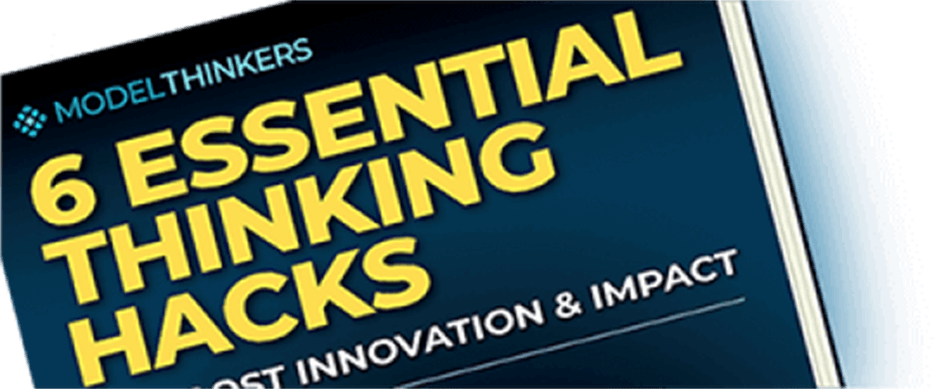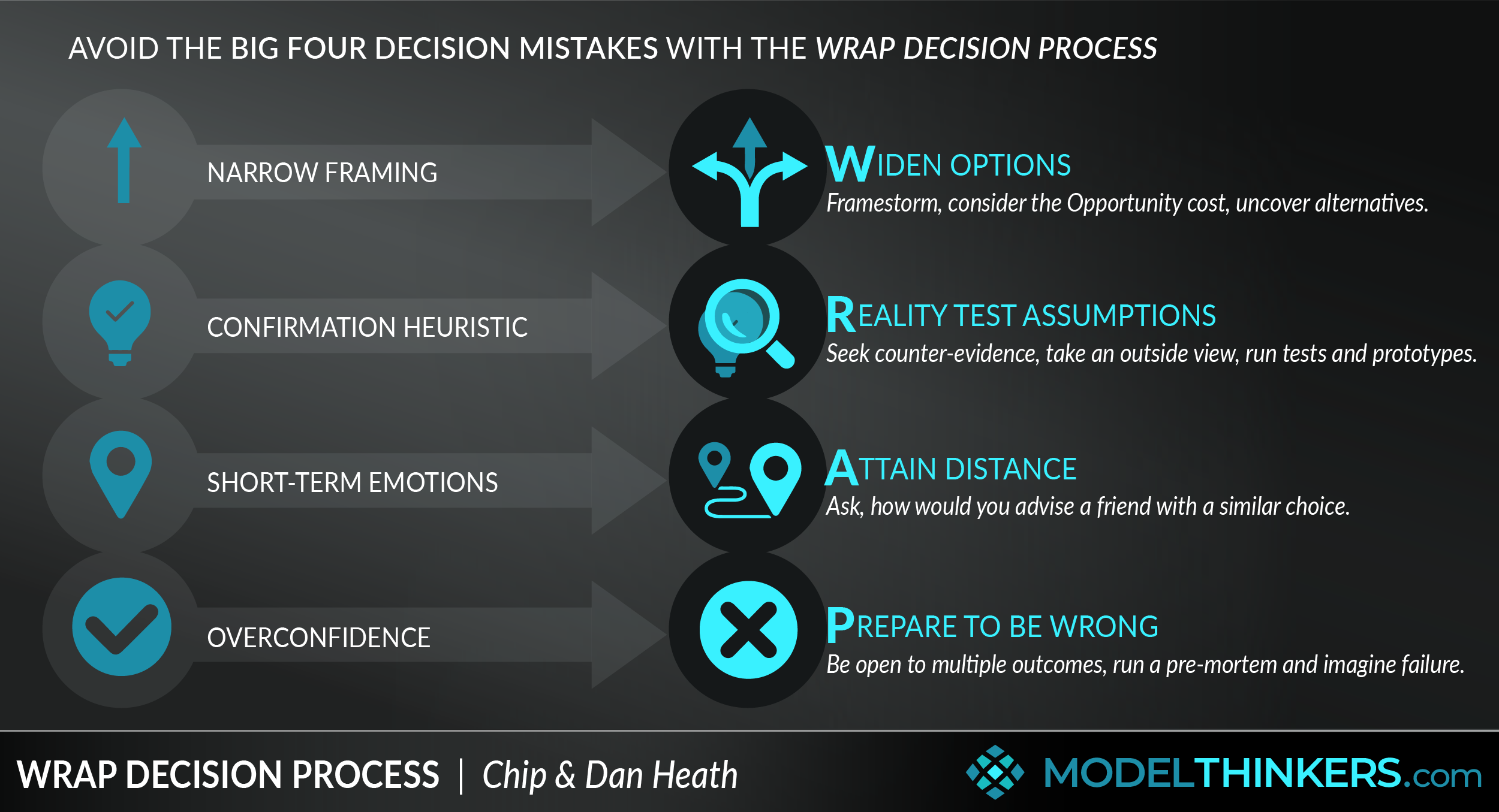WRAP Decision Process
In their best-selling book Decisive, Chip and Dan Heath identified ‘four villains of decision-making’, these are the common pitfalls that we fall into when making a choice. Their resulting decision-making process aims to avoid these villains and empower better decisions.
The WRAP Decision Process includes: Widening your options to avoid narrow framing; Reality testing your assumptions to avoid the Confirmation Heuristic; Attaining distance to avoid short-term emotions; and Preparing to be wrong to avoid overconfidence.
WHY WRAP?
We were immediately drawn to this model because it effectively applies the Inversion approach, one of our favourite models, to decision-making. In other words, rather than obsessing about making great decisions, WRAP empowers you to avoid making bad ones.
In arguing for their model, the Heath brothers note that people tend to overestimate the impact of analysis over the power of an effective decision-making process. They explain: “When the researchers compared whether process or analysis was more important in producing good decisions—those that increased revenues, profits, and market share—they found that “process mattered more than analysis—by a factor of six.
"Often a good process led to better analysis—for instance, by ferreting out faulty logic. But the reverse was not true: Superb analysis is useless unless the decision process gives it a fair hearing.”
APPLYING WRAP.
We know you’re busy, so we’ve distilled the WRAP Decision Process into this quick reference table for you:
DECISION-MAKING CHALLENGES
WRAP DECISION PROCESS
PRACTICAL TECHNIQUES
Narrow framing:
We have a tendency to just consider two counterposed choices.
Widen the frame:
Work to uncover new options that shift the conversation from choosing “This OR That’ to can we do “This AND That.”
Consider the Opportunity Cost of the choice not taken.
Ensure you’re asking the right question by Framestorming.
Multitrack options by experimenting with multiple choices before committing to one.
Consider how others have explored the problem including ‘local’ or familiar examples that have gone well; ‘regional’ examples of best practice; and ‘distant’ or analogous examples from distant domains that can relate to your challenge.
Confirmation Heuristic:
We have a tendency to seek information that supports our beliefs and assumptions.
Reality-test your assumptions:
Ask questions to challenge your current assumptions and seek other perspectives.
Consider what would make the alternative work. Ask what would have to be true to make the option you don’t want the best choice.
Ask questions to seek out counter-evidence by considering what might you see if you were wrong.
Take an outside view by considering your challenge happening to someone else. You might even consider using Rolestorming.
Base rate with expert views, by asking experts what has happened in similar situations.
Consider Prototyping or Split Tests to test your assumptions.
Short-term emotions:
We are less rational than we believe and our physical and emotional state have massive impacts on decisions.
Attain distance before deciding:
Aim to gain a greater perspective or view of the challenge before deciding.
Use the 10/10/10 Method before a decision by considering how you’d feel in 10 minutes, 10 months, and 10 years from now.
View your challenge as though it was happening to someone else, perhaps a friend, and consider what advice you would give them. This can support the Advice Giving Effect.
Use Jeff Bezos’ Regret Minimisation Framework to get in touch with what’s really important to you long term.
Overconfidence:
We tend to believe that things will turn out as we plan.
Prepare to be wrong:
Consider negative outcomes and being wrong.
Think of the future as a range of possibilities rather than a point with Probabilistic Thinking.
Use Inversion and pre-mortems to imagine that you failed and ask what might you have done differently.
Add Redundancy or a Margin of Error to provide padding for your overconfidence.
SETTING TRIPWIRES.
The Heath Brothers implicitly advocate Fast and Slow Thinking and acknowledge that we will generally make irrational, fast decisions left to our own devices. They, therefore, suggest setting ‘tripwires’ which are a form of Nudges to encourage us to focus on decisions more consciously at key moments. They cite the example of Zappos which offers their employees $400 to quit during their induction process, this temptation is a tripwire to force an early decision point for less motivated employees.
IN YOUR LATTICEWORK.
The WRAP Decision Process has connections to many other models and frameworks as you can see from the many links above. WRAP is a form of Inversion in that it avoids the worst of decision-making. In addition, when applying WRAP you can use:
Framestorming and Opportunity Costs to help widen your focus;
Rolestorming and Prototyping to challenge your Confirmation Heuristics;
Advice Giving Effect and Jeff Bezos’ Regret Minimisation Framework to challenge short-term emotions;
And Probabilistic Thinking, Inversion (premortems) and Redundancy or a Margin of Error to challenge overconfidence.
Beyond those models consider applying the WRAP Process in combination with Dave Snowden’s Cynefin Framework to identify the level or nature of complexity you are facing, or as an overlay to Decision Trees.






